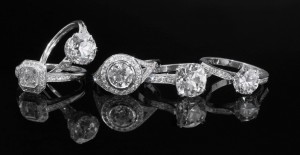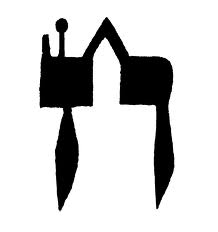Diamonds and Eternal Love (Part 2)
By Sara Esther Crispe: May 8, 2014: Category Decoding the Tradition, Inspirations
The Desire for Endurance
 If I say the word “diamond” what are your immediate associations? I’m going to guess that at least one of these words come to mind: marriage, engagement, commitment, love, money, or a synonymous term.
If I say the word “diamond” what are your immediate associations? I’m going to guess that at least one of these words come to mind: marriage, engagement, commitment, love, money, or a synonymous term.
Most commonly, a diamond is a gift given in love either in or towards marriage. It requires a large amount of money, time and effort as it is a serious investment and one that will hopefully be treasured.
We live in a transient world. Things come and go. Jobs come and go. Money comes and goes. I want something that will always be there. Give me something valuable and precious that will last forever! Authentic diamonds can’t be made, they must be found, like love. And just like every person is unique, every diamond is unique. So when we have found that “one” we want it to be enduring.
This is why the catchphrase “Diamonds are Forever” has been so successful. Coined by De Beers in 1947, it has been used by the world’s most influential diamond cartels in every single one of their advertisements and marketing campaigns. With everything around us changing, and rapidly, people want to know that there are certain precious things that are not changing, are not devaluing and can withstand whatever may come its way.
Diamonds are almost as old as the universe itself. They are the hardest natural material we have. And they essentially last forever. Well before it became tradition to give or wear a diamond ring on one’s hand, the ancient texts of Jewish Mysticism spoke of the power of the diamond. There are numerous sources related to wearing the diamond, specifically embedded in gold, on the left side of the body. When worn, these writings explain that the diamond offers protection, reduces fear and provides support.
Going back hundreds of years we see evidence of diamond rings being given to mark engagements or marriage in various cultures throughout the world. Early Egyptian culture was known to make a circle and tie it around a finger, like a ring, for a circle has no beginning, middle or end and therefore symbolizes eternity.
While under the chuppah, the simple, plain, unadorned gold ring is always put on the right index finger, it is then traditionally moved to the left ring finger where it is often worn alongside a diamond ring if one is given. Our ten fingers are related to the 10 sefirot which are the intellectual and emotive qualities that each of us has. In various commentaries on the oldest of the Kabbalistic texts, Sefer Yetzirah, the hands are discussed at great lengths in charts relating to the various parts. Each of the fingers is associated with a different one of these qualities, and each section of the finger is connected to a different letter. The 22 letters along with the 5 final letters make up for 27 of the 30 parts. And then the 3 letters repeat on the thumbs. The thumbs contain the letters: aleph, yud and kuf which are numerically equivalent to 1, 10 and 100.
So it is quite interesting to note that the left ring finger is associated with the property of Netzach which is the idea of endurance. For something to endure it requires perseverance, patience and ambition (three main qualities very much necessary for anyone dealing with diamonds!) Furthermore, the bottom third of the ring finger, where the ring—the everlasting circle—sits, is related to the letter chet. Chet is the 8th letter of the Hebrew alphabet. Eight relates to infinity, it is one above the natural cycle of the week and takes us therefore into the supernatural.
The form of the letter Chet represents the chuppah which is the marriage canopy. Not only does it look like the marriage canopy itself, but the letter is comprised of the two preceding letters in the alphabet, the 6th letter which is the vav which represents a man standing upright, alongside the 7th letter, the zayin which represents the woman. The zayin is essentially a vav with a crown on top. A crown can even be seen as a jeweled ring sitting on top of the head that is both connected to the head of the person and rises above it simultaneously. Of the seven days of the week, the seventh is Shabbat which we refer to as the Shabbat Queen who is crowned. Furthermore this letter is associated with the verse: “Eshet Chayil ateret ba’alah” “The woman of valor is the crown of her husband.”
 When both of these letters are side by side, they then form the 8th letter. Yet more than just being side by side, they are connected to above, symbolizing the idea that marriage and love are not just comprised of the man and the woman but is greater than the two of them. The marriage is able to be infinite and everlasting when the couple recognizes that what binds them is Infinite. This is even seen in the idea that the Hebrew word for man, ish, and woman, isha both contain the two letters that spell the Hebrew word for ‘fire’, aish. The letters that differentiate them spell one of the names for the Divine. The lesson is that when it is just about the man and woman, their fire will eventually consume or burn out. However, when their Creator is an inherent part of their marriage, then they will always have a fire that illuminates and warms but doesn’t destroy.
When both of these letters are side by side, they then form the 8th letter. Yet more than just being side by side, they are connected to above, symbolizing the idea that marriage and love are not just comprised of the man and the woman but is greater than the two of them. The marriage is able to be infinite and everlasting when the couple recognizes that what binds them is Infinite. This is even seen in the idea that the Hebrew word for man, ish, and woman, isha both contain the two letters that spell the Hebrew word for ‘fire’, aish. The letters that differentiate them spell one of the names for the Divine. The lesson is that when it is just about the man and woman, their fire will eventually consume or burn out. However, when their Creator is an inherent part of their marriage, then they will always have a fire that illuminates and warms but doesn’t destroy.
Likewise a diamond is the epitome of heat resistant. It cannot be melted or burned. And yet it is a source of heat for it is one of the greatest natural heat conductors. One of the tests for ensuring a diamond is real is putting it in intense heat. The real one will not be affected. It will only use the heat for the positive.
In Part Three we will discuss how the diamond not only relates to endurance in Judaism, but is integrally related to love as well.
http://www.interinclusion.org/inspirations/diamonds-and-eternal-love-part-1/














;)
;)
;)
;)
;)
;)
;)
;)
;)
;)
